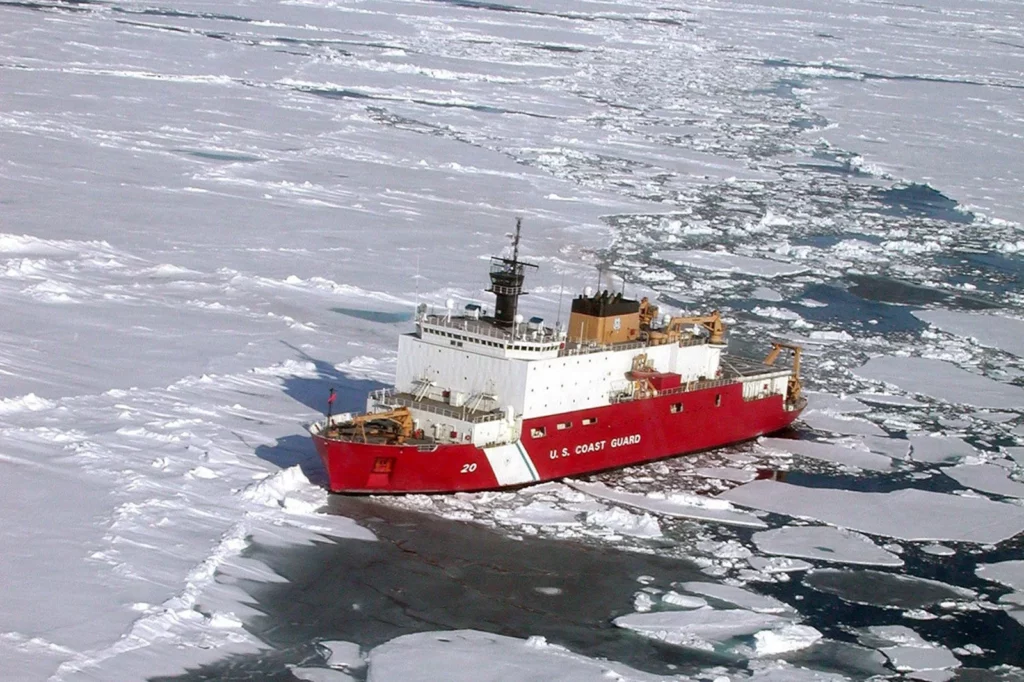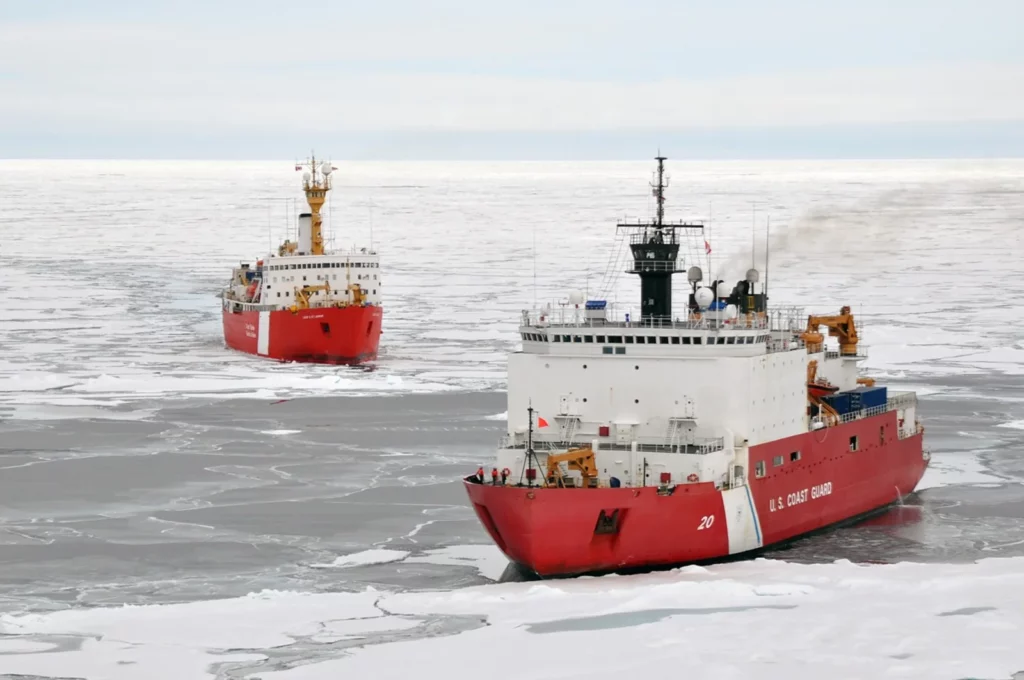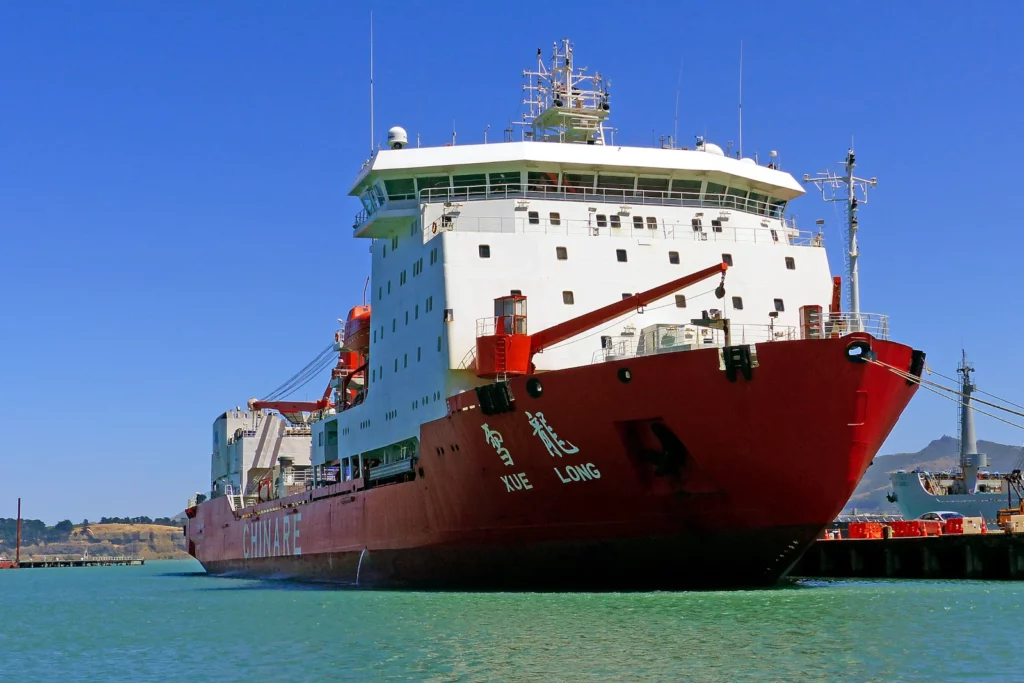Have you ever wondered how explorers and research ships navigate through the coldest parts of the planet? These regions have extremely cold climates where only ice can be seen on the surface of the water and the temperature drops below zero.
Icebreaker ships are a specific type of ship that is designed to break even the thickest of the ice and open up some of the most inhospitable paths in the world, particularly in the Polar Regions.
A stronger hull to withstand icy waters, a specially created ice-clearing shape to build a passage forward, and extraordinary power to navigate through sea ice are the distinguishing characteristics that set ice-breakers apart from other vessels.

The History Of Icebreaker Ships?
The idea of an icebreaker ship has been around since the early days of polar exploration. There are claims that an icebreaker ship was in operation as early as the 11th century. Of course, back then, they were more like boats. The people who lived on the coasts of the Arctic Ocean contributed to the development of early icebreakers.
To cross the icy rivers and seas of Siberia and the Arctic, they built a tiny, one- or two-mast wooden ship. In order to be lifted up if it became stuck in ice fields, these vessels included characteristics like rounded body lines below the water’s surface and a hull-protecting band of ice-resistant flushing skin planking.
New icebreakers were created in later ages utilizing related design ideas. Despite the fact that modernity has undoubtedly increased their efficiency, their basic design hasn’t changed over time.
What Is The Main Character Of Icebreaker Ships?
Today, clearing the commerce routes in the cold waters is an icebreaker ship’s primary duty, especially during the winter. The Baltic Sea, the Saint Lawrence Seaway, the Great Lakes, and the Northern Sea Route all have vessels traveling along them that are built to maneuver through frozen waters, but the seasonal ice conditions make it challenging for the ships to control themselves.
To ensure the commercial vessels’ simple transit through these locations, icebreakers accompany them. The icebreakers are also frequently utilized to help scientific programs carried out in the Polar areas in addition to clearing a path for other vessels.
Returning to the question of the main characteristics of an icebreaker ship, the answer is its hull design. In contrast to other boats, an icebreaker ship’s rounded shape bow allows it to glide more easily over the thick ice coat, substantially lowering the opposing pressures. The ice sheet is crushed when the ship passes over it with its weight bearing down on it.
This ice is pushed away from the ship by its smooth hull, which also keeps it from damaging internal components. The double hull structure guarantees the hull integrity even in the worst weather. To provide the outside hull with more strength and prevent damage from friction, extra materials, and hull polymer coatings are used as reinforcement. As a result of the ship’s forward motion, the ice is pushed aside, opening a passageway for additional ships.

What Are The Pros And Cons Of Icebreaker Ships?
The main pros of icebreaker vessels are as follows,
- Hull shape
As was previously said, the icebreakers’ unique design makes them ideal for carrying out ice-breaking activities. An icebreaker’s sturdy hull is one of its key characteristics. It is very important to have a hull shape that has little ice resistance and can-do various maneuvers as needed. The icebreakers feature a double hull, which consists of two layers of the watertight surface at the bottom and sides of the vessel.
The icebreakers have a sloping stem, sometimes a rounded stem, and sloping sides to improve maneuverability in the icy waters. Additionally, some icebreaking vessels have hulls that are wider in the bow than in the stern to widen the ice passage they carve out.
- Hull strength & material
In comparison to other boats, the hull will be built thicker, and the steel utilized in its construction will be strong enough to withstand low temperatures. Older icebreakers had shell plating that was up to 50 millimeters thick, while newer ships use high-strength steel that has a yield strength of 500 MPa or more, providing increased strength with less steel weight and thickness. The steel utilized for the vessels is effective at resisting brittle fracture under both high loading conditions and cold ambient temperatures.
Similar to a normal ship, an icebreaker needs additional structural strengthening to effectively carry out its functions despite having a sturdily designed hull. Because icebreakers must cut through ice-covered waterways, the bow’s shape is an important consideration. While most vessels have a pointed bow, icebreakers will have a more rounded bow so that they can ride over the ice as well as break it with their weight.
The cons of icebreaker are as follows,
- While icebreaker ships dominate the Polar Regions and ice waterways worldwide, the boats are ineffective outside of their designated areas. The only modest drawback to this design is that it renders icebreaker ships capable of serving only as icebreakers. They excel at what they do without a doubt.
However, because of their unique shape, they are inappropriate for regular waterways. The rounded bow of the icebreakers makes them nearly unseaworthy in calm waters. The design of icebreakers allows the waves to reach the vessel with full power even when a regular hull shape can withstand them, making maneuvering challenging.

How Are Icebreaker Ships Powered?
The ability of modern icebreakers to force a passage for other vessels through the icy waters is one of its many distinguishing qualities when compared to other vessels. The icebreakers have substantially more power than the coal- or oil-fired steamships from older times, modern vessels mostly use diesel-electric or even nuclear power.
Powerful Polar-class icebreakers used by the United States Coast Guard have a diesel-electric and mechanical propulsion system with six diesel engines and three gas turbines that can produce up to 13,000 kW and 45,000 kW, respectively.
The most recent technology introduced to the ice-breaking business is demonstrated by nuclear icebreaker ships. Nuclear icebreakers are the most capable and the biggest icebreakers in the world, which makes them more appropriate for the demanding duty that these ships are designed for.
The work that icebreaker ships do isn’t cooperative in the traditional sense. This makes it a very expensive job, mostly because of the cost of fuel.
An icebreaker would often use more than 100 tons of fuel per day, even for high-return tasks like oil extraction, in areas like the Russian frozen sea with 3-meter-thick ice. Rescue ships with nuclear propulsion arrive in this situation. Under the same circumstances, a nuclear-powered ship would consume less than a pound of uranium, making it a significantly better fuel choice.
Additionally, this eliminates the requirement for fuel refueling, which is essential in the remote, ice-covered areas in which these ships operate. The overall benefits of nuclear icebreaker ships far outweigh their initial development costs.
Operations & Maintenance
Ice breaker ship operations and maintenance involve a variety of tasks and procedures to ensure the safe and efficient functioning of the ship. Some key subtopics within this category include:
- Crew training and qualifications: Ensuring that the crew is properly trained and qualified to operate and maintain the ship, including knowledge of ice navigation and emergency procedures.
- Ice navigation: The use of specialized equipment and techniques to safely navigate through ice-covered waters, including radar, sonar, and ice pilots.
- Power generation and propulsion: The maintenance and operation of the ship’s engines, generators, and propulsion systems, including the use of specialized ice-breaking equipment such as a reinforced bow or an ice-strengthened hull.
- Equipment maintenance: Regular maintenance and inspection of the ship’s various systems and equipment, including the navigation, communication, and safety systems.
- Logistics and resupply: Planning and executing resupply missions to ensure that the ship has the necessary fuel, food, and other supplies to sustain its operations in remote and harsh environments.
- Emergency procedures: Establishing and practicing emergency procedures to ensure that the crew can respond quickly and effectively in the event of an emergency, such as an accident or equipment failure.
- Environmental compliance: Ensuring that the ship’s operations are in compliance with relevant environmental regulations and guidelines, including measures to minimize the ship’s impact on the polar environment.
Summary
Icebreaker ships are essential in facilitating the efficient and safe transportation of supplies and personnel across some of the world’s most hostile conditions. These vessels are constructed and engineered to survive the abrasive arctic environments, and they are outfitted with specific tools and technology to go across ice-covered waterways.
These ships need to be maintained and operated by a trained and committed crew as well as with careful planning and logistics. The need for icebreaker ships is anticipated to rise as new regions of the Arctic and Antarctic continue to become accessible due to climate change, making them a crucial instrument for the maritime industry, scientific study, and even tourism.
- Types of Gas Carriers as per IGC Code – April 22, 2025
- Wind-Assisted Propulsion Systems (WAPS): A Game Changer for Maritime Decarbonization – February 6, 2025
- 10 Boat Salvage Yards in California – January 25, 2025




